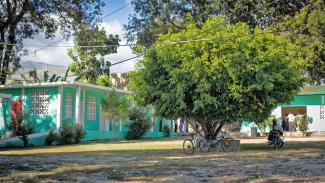Batteries and Battery Management
Batteries provide backup power during gaps in electricity generation. They are critical for some energy systems but are expensive and may require maintenance or replacement. Learn more

An official website of the United States government
Here's how you know
The .gov means it’s official.
Federal government websites often end in .gov or .mil. Before sharing sensitive information, make sure you’re on a federal government site.
The site is secure.
A lock () or https:// ensures that you are connecting to the official website and that any information you provide is encrypted and transmitted securely.
Health facilities can secure power from a local service provider or generate it themselves. Both choices have benefits and drawbacks to consider.
Health facilities are in the business of providing quality health services, not operating energy systems. It is cheaper and less work for health-care facility staff if the facility connects to a national grid or a local mini-grid. If a health-care facility is close to the national grid, an analysis of the grid extension and energy costs may show that a grid extension can provide reliable power for lower prices than generating it on-site. If grid extension is not a cost-effective option, a mini-grid serving a health facility and local community may be a viable solution. Mini-grids based on traditional fuels (and some renewable technologies) sometimes provide intermittent power that is insufficient to meet a health facility’s needs. Even if grid or mini-grid power provides intermittent or low-quality power, uninterruptible power supplies (UPS) can be designed to store intermittent power and condition low-quality power. It is common for health-care facilities to use backup generators as an alternative to UPSs, but the expense and logistics involved in fueling generators can be challenging. Factors that donors, project managers, and facility managers should examine when choosing on-grid back-up and conditioning systems include:
Remote facilities are frequently outside the reach of economically viable grid extensions or mini-grids, so these facilities will have to investigate electrification options that generate power on-site. On-site generation solutions should be evaluated based on local energy availability (like a nearby stream for hydropower or windy conditions for wind turbines) and total installation and operation costs. It is also worthwhile to assess the feasibility of hybridizing multiple energy sources into one energy system. Solar-diesel and solar-wind are common hybrid energy systems that combine the strengths and mitigate the drawbacks of various energy sources. An energy system’s cost is proportional to generation capacity, so it is important to match system generation capacity to the health facility’s typical daily energy needs and planned demand growth without needlessly oversizing the system. Some of the factors that donors, project managers, and off-grid facility managers need to consider when selecting the best technology option include:
Additional information about on-grid backup system options (uninterruptible power supplies), and on-site generation technologies (photovoltaic (PV) arrays and battery and battery management) can be found on the pages linked below.
Batteries provide backup power during gaps in electricity generation. They are critical for some energy systems but are expensive and may require maintenance or replacement. Learn more
Health-care facilities commonly use generators to provide either primary or backup power. While convenient, they require regular maintenance and access to a reliable fuel supply. Learn more
Since batteries and solar photovoltaic (PV) modules produce direct current (DC) power and most common electrical devices require alternating current (AC) power, power inverters are used to convert DC power to AC power. Learn more
PV systems generate electricity from sunlight collected by solar panels. This energy can be used directly or stored in batteries. Learn more
Uninterruptible power supplies provide backup power, protecting equipment from damage in the event of grid power failure. Learn more
Wind turbine systems can yield lower electricity costs than PV generation systems despite their higher maintenance costs, but identifying a suitable wind site is significantly more complicated. Learn more
